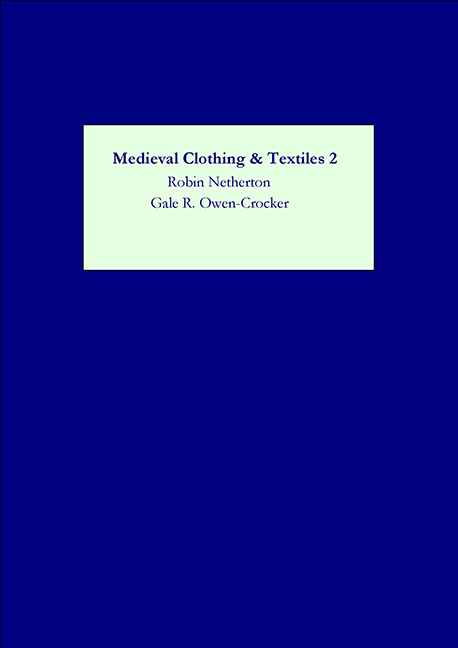Book contents
- Frontmatter
- Contents
- Illustrations page
- Tables
- Contributors
- Preface
- 1 Dress and Accessories in the Early Irish Tale 'The Wooing Of Becfhola”
- 2 The Embroidered Word: Text in the Bayeux Tapestry
- 3 “De Fil d'Or et de Soie”: Making Textiles in Twelfth-Century French Romance
- 4 Biffes, Tiretaines, and Aumonières: The Role of Paris in the International Textile Markets of the Thirteenth and Fourteenth Centuries
- 5 'Clothing Themselves in Acres”: Apparel and Impoverishment in Medieval and Early Modern England
- 6 'Ye Shall Have It Cleane”: Textile Cleaning Techniques in Renaissance Europe
- 7 Fleas, Fur, and Fashion: Zibellini as Luxury Accessories of the Renaissance
- 8 The Matron Goes to the Masque: The Dual Identity of the English Embroidered Jacket
- Recent Books of Interest
- Index
8 - The Matron Goes to the Masque: The Dual Identity of the English Embroidered Jacket
Published online by Cambridge University Press: 14 February 2019
- Frontmatter
- Contents
- Illustrations page
- Tables
- Contributors
- Preface
- 1 Dress and Accessories in the Early Irish Tale 'The Wooing Of Becfhola”
- 2 The Embroidered Word: Text in the Bayeux Tapestry
- 3 “De Fil d'Or et de Soie”: Making Textiles in Twelfth-Century French Romance
- 4 Biffes, Tiretaines, and Aumonières: The Role of Paris in the International Textile Markets of the Thirteenth and Fourteenth Centuries
- 5 'Clothing Themselves in Acres”: Apparel and Impoverishment in Medieval and Early Modern England
- 6 'Ye Shall Have It Cleane”: Textile Cleaning Techniques in Renaissance Europe
- 7 Fleas, Fur, and Fashion: Zibellini as Luxury Accessories of the Renaissance
- 8 The Matron Goes to the Masque: The Dual Identity of the English Embroidered Jacket
- Recent Books of Interest
- Index
Summary
The dawn of the seventeenth century was a time of transition, in art as well as life, from the rigid and stately societal model of the late Elizabethan period to the less formal and more relaxed culture of the Stuart reign. This change is apparent in a group of portraits in which the sitter is wearing a distinctive item of clothing: a highly embellished, embroidered jacket. The depictions of the jackets are stylistically consistent with extant examples, and in one case, a portrait depicts a known surviving garment.
A surprising number of these embroidered upper-body garments (which modern scholars also call bodices or doublets as well as jackets) have survived. The style of these garments is conspicuous and unique to England, with origins in the sixteenth century and the culture revolving around Queen Elizabeth (1558–1603). The jackets became established in their distinct form during the early seventeenth century in the climate of the court of King James I of England (1603–25).
Also surviving are nearly one hundred portraits showing these jackets in wear. Images of women wearing these garments fall into two main categories: the respectable domestic portrait, and the socially significant depiction of the jacket as masque-dress. Participation in the court masque was a coveted social signifier that
I would like to thank the following people for providing advice and encouragement as I researched and wrote this paper: Dr. Michelle Nordtorp-Madson, Dr. Susan V. Webster, Dr. Mireille Lee, Dr. Gale Owen-Crocker, Robin Netherton, the anonymous referee, and Michael Nunn-Weinberg. I am also grateful for the invaluable assistance from Charles Lister of Boughton House and Jennifer Lister of the Museum of London. An abbreviated version of this paper was presented in July 2004 at the International Medieval Congress at Leeds, England.
was limited to a very wealthy, privileged few—those fortunate to be in royal favor.
This paper will examine the styles of jackets in the visual renderings along with the extant examples, and will establish a relationship between this type of clothing and the social milieu in which it would have been worn.
- Type
- Chapter
- Information
- Medieval Clothing and Textiles 2 , pp. 151 - 174Publisher: Boydell & BrewerPrint publication year: 2006

